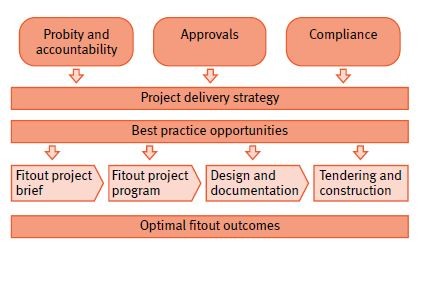Fitout projects can be undertaken using traditional or non-traditional project delivery methods. Traditional methods use separate stages of design, documentation followed by tendering and construction, whereas non-traditional methods can incorporate a range of combinations, up to and including design-and-construct from the project brief. Expert advice is necessary if a non-traditional fitout project delivery method is proposed or under consideration.
Fitout projects in government-owned office buildings are generally carried out by traditional delivery using EPW's construction services and a negotiated fixed price. Fitout projects in space leased from the private sector may also be carried out by EPW but might also be carried out by an agency's contractor or by the building's owner.
Fitout in buildings in which space has been leased under a pre-commitment arrangement is sometimes delivered wholly or partly as a design-and-construct component of the building's construction, based on the tenant-agency's brief.
In the case of new office buildings, it is desirable that fitout projects are integrated into the building's design and construction program in order to save time and cost, maximise environmental performance and to minimise risks.
Time and cost can be saved by installing building elements and services once only in the final positions required for the fitout design instead of installing them 'generically' and later relocating them to meet the requirements of the fitout design. Benefits are also gained through integration to minimised resources required for construction and associated environmental considerations.
Risk can be minimised by having the building head contractor and subcontractors carry out the fitout work to avoid the potential problems of voiding warranties or disputes between subcontractors. Formal building-owner approval needs to be integrated into this process.
Fitout projects that are carried out after a building's completion are also required to meet the requirements of the building's owner. The building's owner can require that the building's original consultants be used to either design the fitout or to check and approve the design. In some cases, the original building-services subcontractors must be used for building work.
When fitout projects are funded wholly or partly through the OAP, EPW requires that the construction be managed by QBuild.



